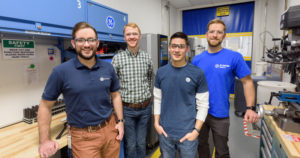Article by Hillary Hoffman
Generative artificial intelligence (AI) is appearing in everything from customer service chatbots to advanced medical diagnostic tools. The technology depends on powerful computer chips that consume massive amounts of energy, raising sustainability concerns.
“Meeting the growing demands of AI requires new chip technologies that are faster and more energy-efficient,” said Vishal Saxena, professor in the Department of Electrical and Computer Engineering at the University of Delaware’s College of Engineering. “Our research explores using light alongside electronics to boost speed, reduce processing delays and lower energy consumption.”
Saxena is co-leading a new three-year, $1.5 million research project funded by the National Science Foundation through its Addressing Systems Challenges through Engineering Teams (ASCENT) program to develop a next-generation chip system that leverages both electronics and photonics, or the use of light. He is partnering with Shayan Mookherjea, professor at the University of California San Diego (UCSD), and Ajay Joshi, professor at Boston University (BU). The grant award will be shared equally, supporting parallel efforts that advance different parts of the research.
The project also will train undergraduate and graduate students in advanced chip design and AI hardware development, equipping them with the skills needed to lead the next generation of AI innovations.
Today’s AI runs on computer chips originally designed to handle graphics. These chips convert information into digital forms—streams of 0s and 1s—to perform computations. Inside the chip, tiny switches flip on or off billions of times per second to represent those 0s and 1s, and each flip uses energy. Because AI requires so many of these operations, powering it demands large numbers of energy-hungry chips.
“Fundamentally, what these chips do is multiply two numbers and add them, in massively parallel fashion—trillions of computations in a second,” explained Saxena. “By shifting much of this bulk computation into the analog domain, in which information is handled as continuous signals instead of being translated into 0s and 1s, we can do the same math with far fewer switches, which can save a significant amount of energy.”
Photonics can perform the multiplication step efficiently, while analog electronics are better suited for the addition step. Photonics also can carry vast amounts of information at once, easily allowing computations to be performed in parallel.

Silicon photonic chip mounted on a PC board. Courtesy of Vishal Saxena.
The researchers will leverage silicon photonics, a technology that uses light to process and transmit information on a chip while working alongside traditional electronic circuits. Saxena’s laboratory will focus primarily on the electronic chips component, while the UCSD team will develop the photonics components. At BU, researchers will create the computing architecture needed for the new photonic-electronic chips to operate in concert at large scale. The groups will work in parallel, coordinating closely with one another.
Following the design phase of the project, the team will fabricate the new photonic-electronic system and use cutting-edge AI models to evaluate its accuracy and energy efficiency.


